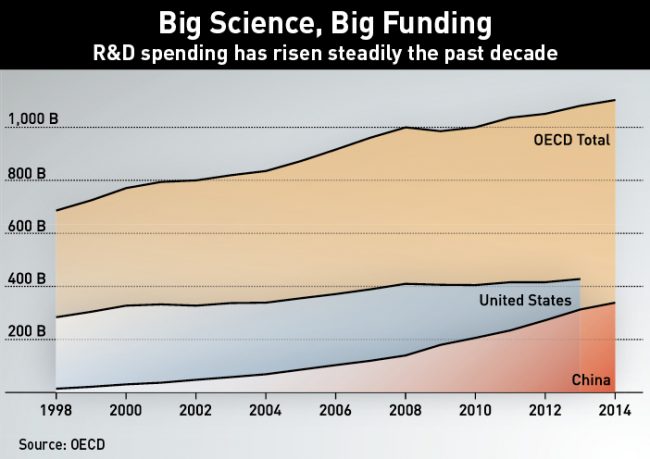China is poised to regain its global prominence as a science leader with many big science projects.
In the countryside of Guizhou, a remote province in China’s southwest, life is slow. Farmer’s work what level land they can find amid the crumpled limestone geography, terracing the hillsides if possible. But recently they’ve made way for a new neighbor—enormous, rounded and glittering like a spaceship. This object, the Five-hundred-meter Aperture Spherical Telescope (FAST), is set to turn on this September and begin peering into the most remote parts of the cosmos, extending the field of mankind’s vision over new horizons.
The monster telescope, costing RMB 1.2 billion ($185 million), will be arguably the most powerful in the world when it opens, but it is soon to be joined by an even bigger instrument. FAST’s sister project, the Square Kilometer Array (SKA), is slated to begin construction in 2018 in the desert hinterlands of South Africa and Australia. SKA is an order of magnitude more complex and challenging than FAST, and on the frontier of what is possible.
China is one of 10 key players in the SKA project, which is of such proportions and requirements that no single nation could shoulder it. And as such, the project is a milestone in China’s entrance to the global stage of Big Science, and return to scientific glory.
“Over the past 200 years, Chinese civilization has been in decline,” says Chi Maoyen, Asia CEO for Cold Spring Harbor Asia in Suzhou, the first international branch of the famed New York institution where DNA was discovered. The nation, he says, is craving resurgence, and becoming a scientific power once again will help “regain the ancient glory shared by this country for more than 1,000 years.” Cold Spring Harbor Asia hosts symposia connecting top global scientists with each other, and to Suzhou’s emerging biotech industry.
Other “Big Science” projects being undertaken by China, either solely or in international partnerships, include the Shanghai Synchrotron Radiation Facility that provides high-energy radiation for various research projects, the Experimental Advanced Superconducting Tokamak in Hefei that researches fusion power, the Beijing Electron-Positron Collider, a type of particle accelerator, and the Daya Bay Reactor Neutrino Experiment near Hong Kong that researches one of the most elusive particles in the universe.
These projects are almost completely state-funded, and are always extremely expensive. They are part of the reason China’s total R&D spending (both public and private) has grown at an annual rate of 20% over the last decade, reaching RMB 1,330 billion ($204 trillion) in 2014—and why the OECD predicts that China will overtake the US in research spending by 2020.

The reasons for investment in projects of this scale are multifaceted. In addition to the scientific desire to push the limits of understanding and the nationalistic desire for renewed glory, there is the practical need to foster new industries and the knowledge economy. Big Science projects are often daring creations, drawing as much on faith in the future as the resources available. The fact that facilities such as FAST even exist at all is a powerful testament to the resurgence of the Chinese economy over the past few decades.
But becoming a global leader in large-scale research is not as simple as just spending vast amounts of money and building huge facilities. In order to become the innovative global research hub it longs to be, China still has to face down serious problems in bureaucratic organization, corruption, education and a research culture that may not best serve the cause of scientific advancement.
“I think a successful research and innovation system is really critical to moving [to the next stage of development], but the larger political and economic obstacles, the institutional obstacles, are pretty daunting,” says Richard Suttmeier, professor emeritus at the University of Oregon, and expert of Chinese science policy and US-China science relations.
Big Science, Big History
The new global era of “Big Science” began around World War II with the Manhattan Project, the enormous US project to build the first atomic bomb in the early 1940s. In contrast to traditional science, with smaller labs and a limited number of researchers, the resources of the state were brought to bear, huge facilities were created with the organization of many thousands of people across different disciplines, long-haul commitment, and of course deep wells of money.
Those basic characteristics are the marks of Big Science, and they can readily be seen in many other projects of the latter 20th century that helped give Big Science its big reputation. NASA’s space programs are an obvious example, as is CERN’s Large Hadron Collider (LHC), the $9 billion, 21-nation, 10,000-scientist particle smasher straddling the border between France and Switzerland.
Mustering the resources for projects of such a caliber requires nations to have already achieved a high degree of industrialization and development. While China was a world scientific leader in the past—being the first to develop, amongst many other things, the compass, the printing press and gunpowder—it went into decline before industrialization began.
For most of the 20th century, China was in turmoil and by the time of Deng Xiaoping’s return to power in 1978, the West was already decades into the era of Big Science. But the rapid economic development that followed set the stage for a new act in the early 21st century. Today’s China is industrialized, technologically advanced, economically huge and hungry to move ahead.
“The government now has the money [and] is willing to spend money on research, and on science and technology,” says Cao Cong, professor of Chinese Studies at The University of Nottingham Ningbo, and an expert on Chinese science and technology policy.
The broad economic changes scientific development can help deliver could be even bigger than the changes that preceded it— and the pursuit thereof is a necessity. The 13th Five-Year Plan declared that China’s future development “must rest on the basis of innovation,” announcing aims to set up several national laboratories in the next five years.
“In a practical sense, for a country to survive in today’s ever-competitive world, you have to have a strong science and technology [base],” Cold Spring Harbor’s Chi says. “To make Chinese civilization [have a] renaissance, the government and the country realize that science is an absolutely important part.”
Deep Impact ROI
While “big” is the most obvious characteristic of any of these projects, the second hallmark is the lack of any direct commercial or economic goal, despite the outlay of what can easily be billions of dollars in funding. That does not, however, mean that there isn’t any ROI (return on investment), or that governments and institutions don’t expect a bang commensurate to the buck in some way and at some point.
The expectation is that undertaking such boundary-pushing projects can and should lead to boundary-pushing developments that have uses far afield from the original goal. Indeed, work at CERN’s LHC resulted in researchers inventing the World Wide Web portion of the internet that dominates all our lives. It also gave us the MRI machine, magnetic resonance imaging, the donut-shaped apparatus in hospitals that delivers high-resolution images of our insides.
Although inherently unpredictable, the consistency of game-changing spin-offs has become an integral part of the Big Science pitch. The partners working at SKA, which will be built in two phases, are particularly excited about this.
“Just phase one will generate so much data [that] it will be larger than today’s internet,” says Wang Qiming, Head of Policy Development at SKA Organisation. That volume of big data, matched with the remoteness of the instrumentation will necessitate new means of data distribution and analysis techniques. “[It] will change the future of handling data.”
And by being a key player in the project, China will be on the crest of the wave of developments as they occur, with all the obvious advantages that will accrue.
But the timeline for the payoffs from such massive Big Science projects can be as distant as decades. To balance that, the near-term holds a different kind of reward altogether: prestige and influence.
“I think the Chinese are really trying to make a statement about scientific capabilities by building a lot of these things. And you know, other places are budget constrained, and seeing the Chinese do it I think is welcome,” says Suttmeier.
Just the fact of having a world-class facility makes China an attractive destination for many scientists around the globe. But such facilities are far from being mere centerpieces of soft-power discussion, or far-future dreaming. They have a real impact on the much sought-after economic transition—that is the need to construct an economy that revolves around technology and innovation rather than low value-added production.
“The returns will not be immediate in terms of technologies… but these big activities are very important for building skills, building capacity,” says Carthage Smith, lead co-coordinator of the OECD Global Science Forum. “In the short term, it’s probably more about national prestige and country building than immediate economic [benefit]… But in the longer term it will underpin the innovation of the future.”
The Chinese government was aware of this reality at least as far back as 10 years ago. Back in 2006, when the annual GDP growth rate was knocking on 13%, China launched the National Medium- and Long-term Plan for the Development of Science and Technology. The 15-year plan emphasized “indigenous innovation” and set the goal of becoming a global “scientific powerhouse” by the year 2020. Although what exactly constitutes a scientific powerhouse may be unclear, the central government has left no doubt about its willingness to aggressively pursue technological development on everything from aircraft engines to quantum physics.

“Pursuing these projects will help China break free from external dominance in these strategic areas, and create new directions and areas for development and growth,” President Xi Jinping stated last year, elaborating on the Communist Party’s proposal for the 13th Five-Year Plan.
But in some fields the future has already arrived, and it is bringing tangible benefits. Perhaps the best example is BGI, formerly the Beijing Genomics Institute. BGI played a small role in the Human Genome Project of the 1990s and early 2000s, which mapped the basic human genetic code in its entirety—it was a first for China to be involved in such a project, and despite the bit part, then President Bill Clinton made a point to thank China publicly.
Following the completion of the project in 2003, BGI found itself with state-of- the-art equipment, highly-trained staff, and mature gene sequencing techniques. It went on to become the world’s largest gene sequencer, partnering in multiple marquee projects as well as offering private services. The lab has spent periods as both an independent and state-funded operation, but is currently planning an IPO.
While there is no ‘ideal’ outcome for a Big Science project, the continuing success of BGI hits the main targets: historic scientific achievement, world-changing technology, development of a private industry, and last but not least, recognition.
“Initially there was some skepticism, even ignorance of what China could do in that field, and China quickly demonstrated that actually it could contribute at a very high level,” says OECD’s Smith. “There’s no longer that sort of skepticism [in genetics].”
FAST is similar to BGI in that it is less a statement about the future than it is about the past and present. Headlines heralding the opening of a “new” telescope belie the fact that the project is already some 22 years old, a totally ordinary Big Science timeline. FAST is still a visionary project, but when it was proposed in 1994, it have been considered a moonshot.
“China before was doing… what we call ‘catch-up’ strategy,” says Wang. “In the new century the strategy has been changed to encourage China to join together along with the mega international research projects.”
Colossal Challenges
But despite the achievements so far, Big Science in China is at a crossroads, one that mirrors many of the problems China faces in the wider spectrums of economics, government and society. Like problems in these other areas, the issues in the scientific community cannot be wholly solved with redbacks and good intentions—the two things of which China has the most ready supply.
The first problem is familiar to even the most casual of China watchers: bureaucracy. The state science system is a maze of institutions and programs grown together in a tangle.
“Various government agencies have their own kind of mission… [their] own kind of national science program,” says Cao. “They are often overlapping, and there is redundancy, in terms of organization, and even in terms of the grantees of some of these programs.”
Like many other issues, China is not at all blind to this. Since 2014, China has undertaken a massive reform program in the sprawling Chinese Academy of Sciences, which supports state science funding. It’s taken hundreds of different projects and re-categorized them into a streamlined system of five channels. But the problem of messy organization continues to result in waste, subverting the money being spent.
“Since the year 2000 or so, you’ve seen very steady increases in R&D spending, but I think that the spending has outpaced institutional design,” says Suttmeier. “I don’t think they had everything in place to make the most use of all the money that was being spent. And so that has resulted in waste and misconduct and fraud and so on.”
The waste here is an interesting case as it is not, as Suttmeier puts it, the result of “sins of commission,” but rather the result of a clunky, knotted system of doing things. According to him, it is bad project selection, duplication of projects, hot topics that result in wasteful science land rushes of everybody pushing into the same territory and so on.
As far as outright corruption, a good portion of this stems from how scientists are paid. Unless you become famous, base salaries can be very low, sometimes just $20,000 per year, and so for a long time researchers filled in their financial gaps with grant money.
“They are poorly paid. So for a period of time, the government has tolerated scientists using part of the grant to pay their salary,” says Cao.
Such a system can invite abuse, and of course there are cases where it has been abused. It naturally follows that abuse demands a crackdown, which already happened as part of reform measures. But in an ironic twist, although many of the channels for this type of corruption have been closed off, the antecedent issue of low pay remains, according to Cao.
A related problem is China’s culture of research, stemming largely from how scientists are evaluated and promoted. Success in the academic science system hinges on researchers publishing papers—and what matters most is being the lead author with your name at the top. As Cao explains, if you are the second guy, or third guy on the list, you don’t get a lot of credit for your contributions.
“It basically discourages scientists from working with their peers,” Cao says.
Similarly, there’s an issue of access across different institutions, which can be a vital need, especially if research is interdisciplinary. According to Suttmeier, the central authorities have been pushing for a more open system to ensure that big facilities are not monopolized by the organization in which they are housed.
Cold Spring Harbor’s Chi, however, points out that this is far from a uniquely Chinese problem. “That also happens in the states, or elsewhere in the world, because scientists all have a community by themselves, and scientists have their rivals working in different camps, or working in different fields that compete with them,” he says. “I think this is a challenge for every government.”
A more pressing problem is the issue of the quality and quantity of the researchers themselves—which relates to China’s socalled‘brain drain’ problem. However, the tide has to some extent been turning, following concerted efforts by the government to attract top scientists, both Chinese who have left as well as foreigners.
“In recent years China has seen a significant amount of people returning from overseas. Some of them are excellent scientists, many of them are probably still mediocre,” says Cao. “In the first-class labs you see second-class people working.”
The SKA telescope, because of its size and cutting-edge technologies, faces a similar personnel obstacle in finding enough qualified researchers.
“Chinese astronomers are not enough, there are only a few people,” says Peng Bo, the Chinese Science Director on the SKA Board, deputy project manager of FAST, and member of China’s National Astronomical Observatory. “We also need to attract people from overseas, Chinese and foreigners…. [We] also need to train the younger generation.”
The biggest challenge, however, may be the one thing that is least likely to change: strong government control of society and the economy.
“[Some things] really seem to work against the building of a truly innovative society, starting with the internet craziness,” said Suttmeier, in reference to the so-called ‘Great Firewall.’
Standing Level With the West
But no matter how serious the issues are, when it comes to the goal of matching Western developed nations in terms of scientific development, it is important to remember a few things. The first is resource advantage.
“China now is sending rockets into space to look at dark matter,” says the OECD’s Smith, referring to China’s Dark Matter Particle Explorer. “Other countries don’t have the resources to do that. Even the US is struggling to do that sort of thing.”
Attendant to that resource advantage is just how projects get developed and money gets spent. As both Cao and Suttmeier point out, if the government decides it wants to do something, fund a particular project and pull out all the stops, it can do that. There is no debate about it. In terms of mobilizing enormous resources very quickly, China is probably unmatched.
Another advantage, although intangible, cannot be discounted: raw desire for a resurgent China. It exists at the highest levels of government, with the people who make the big decisions. And this literally reach-for-the-stars attitude is of course a key feature of the people directly involved in SKA. They ooze an almost gladiatorial optimism.
“We want to achieve our ambition of building the largest telescope ever, in the history of the world,” says Wang, whose been working on SKA for some two decades.
For such insiders, there is no obstacle too great. Outside observers, meanwhile, tend to opt instead for cautious optimism on the future of China as a research nation.
“Given the investments that have been made, physically and in the human resource base, you will see steady progress,” says Suttmeier.




















